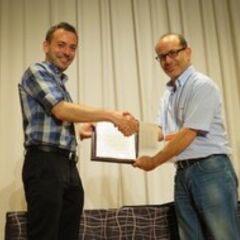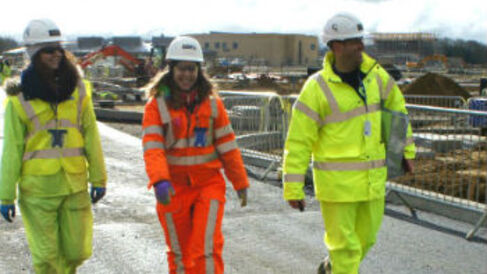News Archive 2016-2015
2016
Best Student Paper Award and Best Student Presentation Award at the ICCCBE 2016 Conference for the CIT Lab


The CIT lab has excelled at the ICCCBE 2016. Our group published five papers and two of the students, Ioannis Anagnostopoulos (pictured far left) and Steven Vick, won the Best Student Paper award and the Best Student Presentation award respectively.
More information can be found here.
Submitted by Administrator on Thu, 11/24/2016 - 15:22
Trimble Partners with the University of Cambridge to Collaborate on Research in Engineering and Construction Technology
Cambridge CIT lab is pleased to announce a research partnership with Trimble Navigation Limited. Trimble has been developing technologies, for the construction industry, closely aligned with the interests of the CIT lab ranging from core positioning technologies to advanced imaging and point cloud capabilities to BIM software and mixed reality applications. The partnership will assist research projects within engineering department over a period of 10 years. Further information relating to this collaboration came be found here.
Submitted by Administrator on Tue, 04/26/2016 - 11:12
PhD student at the CIT lab was awarded the 2015 Outstanding Student Research Project award by Fiatech
Stefania C. Radopoulou, was awarded the 2015 Outstanding Student Research Project award by Fiatech at this year’s 3-day event, which was held at the Hyatt Lost Pines resort in Austin, TX on April 4-6.
Fiatech is an international community of global leadership organizations focused on innovation in the capital projects industry. The organization's Celebration of Engineering & Technology Innovation (CETI) Awards recognize organizations who have implemented new and emerging technologies and innovative practices in capital projects/facilities and recognize individuals who have made significant strides in advancing technology and innovation in research and development.

Stefania has a BEng-MEng in Civil Engineering and a MSc in Engineering Project Management from the Aristotle University of Thessaloniki in Greece and a MSc in Transportation from the Massachusetts Institute of Technology in Cambridge, MA. Her PhD research is in the areas of computer vision, image processing and machine learning where she has made significant contributions in the field of computing for civil engineering practices.
Submitted by Administrator on Wed, 04/20/2016 - 16:54
Data Collection
CIT lab, with the help of Trimble UAS team, visited a site at North West Cambridge for some data collection.
Visit here and here to see more photos from this fun day!

Submitted by Administrator on Mon, 03/21/2016 - 11:33
2015
Structures Seminar Friday 4th December will be given by Eirini Konstantinou
This week’s seminar will be given by Eirini Konstantinou who is part of the Laing O'Rourke Centre for Construction Engineering and Technology Group at 3pm at LR3B.
Title: 3D Matching of resource vision tracking trajectories
Abstract:
Issues related to management and workforce play a key role in the productivity gap of construction and manufacturing. Both issues are directly related to the way productivity is measured. Current measurement methods tend to be ineffective because they are labour intensive, costly and prone to human errors whereas they are mainly reactive processes initiated after the detection of a negatively influencing factor. So far, research efforts in automating the measuring process have not achieved full automation because they require prior knowledge of the type of tasks performed in specific working zones. This is highly associated with the lack of depth information. For this purpose, we propose a computationally efficient computer vision method for matching construction workers across different frames based on epipolar geometry and past motion 2D data. The main result of this process is to provide a method for the acquisition of the 4D features (x, y, z, t) that compose the detailed profile of a construction activity in terms of both time and space.
Submitted by Administrator on Fri, 12/04/2015 - 11:29
"Integrated Imaging and Vision Techniques for Industrial Inspection"
A new book has been released on vision based industrial inspection with the title "Integrated Imaging and Vision Techniques for Industrial Inspection" from Springer. The CIT group has contributed one of the chapters of the book (Chapter 11 - Machine Vision Techniques for Condition Assessment) which is related with the research is being done in the lab.
Submitted by Administrator on Wed, 11/04/2015 - 16:24
Prof. Antonis Argyros is visiting Cambridge for a talk on "Observing hands in action"
Professor Antonis Argyros from the Department of Computer Science will be presenting his research in computer vision with the title "Observing hands in action". In this talk, he will provide an overview of the work on computational methods for tracking and understanding the activities of human hands based on unobtrusive computer vision techniques that rely on the processing and analysis of markerless visual data. He will present methods for the detection and tracking of hands and fingers in 2D, with emphasis on occlusions handling and illumination invariance. His focus will be on a computational framework for tracking the 3D position, orientation and full articulation of human hand(s) from markerless visual observations. He will show how this framework is employed to solve problems of varying complexity, ranging from 3D tracking of a single hand to 3D tracking of two hands interacting with several objects. Finally, he will show how his work can support humanoid robot learning by demonstration, intuitive HCI and HRI as well as the development of interactive exhibits in the context of smart environments.
Date: Monday November 9th, 11am.
Location: Engineering Department - Sir Arthur Marshall Meeting Room (2nd floor, Inglis Building)
Submitted by Administrator on Tue, 11/03/2015 - 16:21
CIB W78 2015 Conference
Marianna Kopsida, Ioannis Anagnostopoulos and Manuel Davila, members of the CIT group, participated in the conference and presented their papers. For more information about the papers you can visit the Conference Proceedings.
Submitted by Administrator on Tue, 11/03/2015 - 12:01
Prof. Patrick Xiaowei Zou visited the CIT lab
Dr Patrick Xiaowei Zou is a Professor of Construction Engineering and Management in the Department of Civil and Construction Engineering and Research Leader of Construction Engineering and Management in the Centre for Sustainable Infrastructure (CSI) in Swinburne University of Technology and he visited the CIT lab.
Submitted by Administrator on Mon, 09/07/2015 - 13:59
Efficiency Through Digital Projects Conference
The 2nd annual Efficiency Through Digital Projects (ETDP) Conference will take place in London 10-11 November, 2015. The conference will have sessions in Computing, Automation, Robotics and Big Data for project managers, business development directors and senior executives. Attendees will engage in debates with industry leaders and participate in interactive panel sessions.
During the conference, Dr Brilakis will give a keynote speech on “Digitising Bridges” and its opportunities and challenges pertaining to digital inspection and maintenance of bridges.
Submitted by Administrator on Wed, 08/26/2015 - 13:44
Bridging the digital gap
Neil Farmer of Tony Gee explains how new research into digital engineering of bridges could revolutionise bridge design, construction and maintenance in the Journal of Infrastructure Intelligence.Experts from Tony Gee, Laing O' Rourke and University of Cambridge will embark on a two year research project to digitally enable the design for manufacture, assembly and maintenance of bridges. For more information please visit the original article here.
Submitted by Administrator on Mon, 08/03/2015 - 11:42
Digitising the construction sector
Laing O’Rourke, Tony Gee & Partners and Cambridge University are collaborating as part of a £6M investment of Innovate UK, in order to digitise the process of desing, manufacture and assembly of bridges. For more information please visit the original article "10 ways to digitise the construction sector: No. 1 BIM for bridges".
Submitted by Administrator on Mon, 07/13/2015 - 11:13
New technologies for old problems
The CIT team contributed to the research regarding the assessment of 3D survey technologies for repairing and maintening cultural heritage buildings. For more information please visit the original article "New technologies for old problems".
Submitted by Administrator on Mon, 06/08/2015 - 11:20
Dr Brilakis is giving a talk on “Digitizing Bridges” at the ICE Bridge Conference 2015
Dr Ioannis Brilakis will be speaking at the ICE Bridges conference on 5th of June.
Submitted by Administrator on Mon, 06/08/2015 - 11:13
Digital Infrastructure Models: a necessary foundation for the next IT wave
University of Cambridge is working up inexpensive commercial DIM models and Laing O’Rourke lecturer of construction engineering Dr Ioannis Brilakis explains why in the Infrastructure Intelligence Magazine.
For the original article you can visit here.
Submitted by Administrator on Mon, 04/27/2015 - 10:46
Laing O' Rourke leads on the automated manufacture
A recent article by Mark Hansford, editor of New Civil Engineer at EMAP, discusses comments by Laing O’Rourke Construction Hong Kong non-executive chairman Doug Oakervee at NCE’s pre-Consultants Awards Executive Briefing. Mr Oakervee believes that major Chinese engineering firms will have bought their way into the UK infrastructure market by 2020. Rather than fight this trend, Mr Oakervee proposes that we get ahead of the curve, and show Chinese suitors that we are already the best that we can be. One example cited was Laing O’Rourke's research on automated manufacturing of a set of standardised, validated parts and sub-assemblies for the most common bridge types. The Construction Information Technology Group contributes to this effort.
You can find the original article here.
Submitted by Administrator on Wed, 04/01/2015 - 10:16
Professor Leonidas J. Guibas is visiting Cambridge
January 15th - Professor Guibas heads the Geometric Computation group in the Computer Science Department of Stanford University and is a member of the Computer Graphics and Artificial Intelligence Laboratories. He works on algorithms for sensing, modeling, reasoning, rendering, and acting on the physical world. Professor Guibas' interests span computational geometry, geometric modeling, computer graphics, computer vision, sensor networks, robotics, and discrete algorithms. Students could have the opportunity to talk to him and exchange ideas.
Submitted by Administrator on Fri, 01/09/2015 - 19:31
Seminar on simulation games and engineering education
Can simulation games teach (construction)?
Presenter: Dr Dragana Nikolic
Date: Friday January 16th
Time: 16:10
Location: Sir Arthur Marshall Meeting Room
Visualising the built environment and construction processes is a complex task and a critical skill in the design and construction disciplines. Growing evidence suggests that employing innovative teaching approaches such as interactive simulation games, offers more active, hands-on and problem-based learning opportunities to integrate and test acquired knowledge more closely aligned with real-life construction scenarios. Yet, the debate on the effectiveness of games in education remains largely controversial. From simplistic to those developed as complex learning systems, games can provide their players with a powerful learning amenity to fail with no real world risks, and in this process shift between in-game role-playing and outside-game reflecting on the outcomes. Still, their essence of also being fun tends to have them dismissed as a “motivational fluff”. Ongoing development of the Virtual Construction Simulator game explores some of the remaining questions on the effectiveness and the pedagogical value of simulation games in teaching the difference between as-planned and as-built schedules as a result of dynamic project changes. Focusing on to-date experiences with the VCS implementation in class, my talk will provide an overview of this exciting and engaging education model to supplement the traditional techniques currently used in engineering education, along with insights and impact on learning design and construction concepts.
Submitted by Administrator on Fri, 01/09/2015 - 19:22
